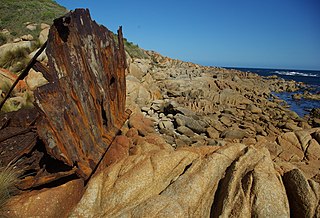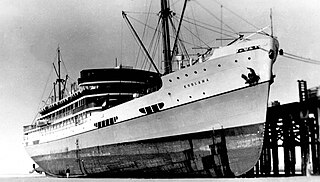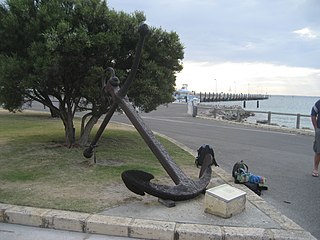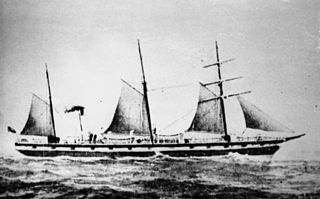
The maritime European exploration of Australia consisted of several waves of European seafarers who sailed the edges of the Australian continent. Dutch navigators were the first Europeans known to have explored and mapped the Australian coastline. The first documented encounter was that of Dutch navigator Willem Janszoon, in 1606. Dutch seafarers also visited the west and north coasts of the continent, as did French explorers.

SS Saros was a 2044-ton steamship which was wrecked at Point Hicks, in what is now Croajingolong National Park. Helmed by a Captain Aitken, it left Geelong bound for Sydney on 23 December 1937, but ran aground in heavy fog. All crew on board were rescued after a distress signal brought assistance from other ships.

Willem Hesselsz de Vlamingh was a Dutch sea captain who explored the central west coast of New Holland (Australia) in the late 17th century, where he landed in what is now Perth on the Swan River. The mission proved fruitless, but he charted parts of the continent's western coast.
Ridderschap van Holland was a large retourschip, the largest class of merchantmen built by the Dutch East India Company to trade with the East Indies. In 1694 the ship sailed for Batavia on her fifth voyage, but was never heard from again. She is now thought to have been shipwrecked off the west coast of Australia.

SS Maheno was an ocean liner belonging to the Union Company of New Zealand that operated in the Tasman Sea, crossing between New Zealand and Australia, from 1905 until 1935.

Eendrachtsland or Eendraghtsland is an obsolete geographical name for an area centred on the Gascoyne region of Western Australia. Between 1616 and 1644, during the European age of exploration, Eendraghtsland was also a name for the entire Australian mainland. From 1644, it and the surrounding areas were known as New Holland.
Over 1400 ships have been wrecked on the coast of Western Australia. This relatively large number of shipwrecks is due to a number of factors, including:
't Wapen van Hoorn was a 17th-century Dutch East India Company fluyt with a tonnage between 400 and 600, built in the Dutch Republic in 1619. During its second voyage it grounded on the west coast of Australia, making it about the tenth ship to make landfall on Australian soil, and following Tryall just a few weeks earlier only the second ship to be shipwrecked in Australian waters, albeit temporarily.
Vianen was a 17th-century Dutch East Indies Company sailing ship, used to transport cargo between Europe and the Indies. She was shipwrecked but refloated on her first voyage, and shipwrecked and sunk on her second. Built at Amsterdam in 1626, she had a gross tonnage of 400.

MV Koolama was an Australian merchant vessel that sank as a result of several attacks by Japanese aircraft in February–March 1942. It was also the centre of the Koolama Incident, an alleged mutiny resulting from these attacks.

Since the first Europeans visited the west coast of Australia in the 17th century, Rottnest Island has seen numerous shipwrecks. The 11-kilometre (6.8 mi) long and 4.5-kilometre (2.8 mi) wide island is surrounded by hidden and partly exposed reefs whilst being buffeted by north-westerly winter gales as well as very strong south-west summer sea "breezes". It is situated 12 kilometres (7.5 mi) west of the port of Fremantle meaning that much of the maritime traffic to Western Australia's major port passes close by.

SS Gothenburg was an iron-hulled sail- and steamship that was built in England in 1854 and sailed between England and Sweden until 1862. She then moved to Australia, where she operated across the Tasman Sea to and from New Zealand until 1873, when she was rebuilt. After her rebuild, she operated in the Australian coastal trade.

The Backstairs Passage is a strait in South Australia lying between Fleurieu Peninsula on the Australian mainland and Dudley Peninsula on the eastern end of Kangaroo Island. The western edge of the passage is a line from Cape Jervis on Fleurieu Peninsula to Kangaroo Head on Kangaroo Island. The Pages, a group of islets, lie in the eastern entrance to the strait. About 14 km wide at its narrowest, it was formed by the rising sea around 13,000 years ago, at the end of the Pleistocene era, when it submerged the land connecting what is now Kangaroo Island with the Fleurieu Peninsula. Backstairs Passage was named by Matthew Flinders whilst he and his crew on HMS Investigator were exploring and mapping the coastline of South Australia in 1802.

Loch Vennachar was an iron-hulled, three-masted clipper ship that was built in Scotland in 1875 and lost with all hands off the coast of South Australia in 1905. She spent her entire career with the Glasgow Shipping Company, trading between Britain and Australia. The company was familiarly called the "Loch Line", as all of its ships were named after Scottish lochs. The ship was named after Loch Venachar, in what was then Perthshire.

The Adolphe was a sailing ship that was wrecked at the mouth of the Hunter River in New South Wales, Australia, in 1904. The ship is now the most prominent of several wrecks on what is now the Stockton breakwall, which protects Newcastle harbour. The rescue of the ship's crew has gone down in local maritime history as one of the most remarkable in local waters.

The Fitzroy was a steel-hulled steamship built in 1912 at Old Kilpatrick, Scotland in 1912. Thirty-one people were killed when Fitzroy capsized in a gale whilst carrying a general cargo between Coffs Harbour and Sydney off Cape Hawke, New South Wales on 26 June 1921.

The Gulden Zeepaert was a ship belonging to the Dutch East India Company. It sailed along the south coast of Australia from Cape Leeuwin in Western Australia to the Nuyts Archipelago in South Australia early in 1627.

The Willem River or Willem's River was named during the voyage of the Dutch East India Company ship Mauritius in 1618, under the command of Supercargo Willem Janszoon and captained by Lenaert Jacobszoon, and is one of the few features named on a nautical chart made in 1627.













